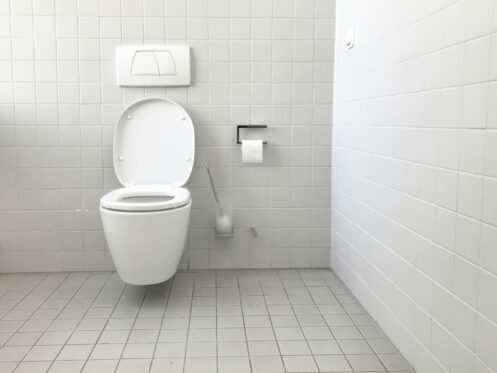Toilet overflows can be a real headache. One moment, everything is fine, and the next, water is spilling onto your bathroom floor. Knowing what to do right away can make a big difference, minimizing damage and stress. Acting quickly and understanding the causes behind an overflow can help you get the situation under control in no time.
There can be many reasons why your toilet overflows. It could be something simple, like a clogged pipe, or more complex, like an issue with the sewer line. Identifying the cause helps in choosing the right solution. Plus, knowing why it happened can prevent it from happening again in the future.
In this guide, we will go over the immediate actions you should take when your toilet overflows, how to figure out what caused it, and steps to unclog your toilet. We’ll also discuss some simple preventative measures to keep your toilet running smoothly. This way, you’ll be well-prepared to handle any toilet overflow situation with confidence.
Immediate Actions to Stop the Overflow
Quickly shutting off the water supply is the first and most crucial step when your toilet overflows. Find the water shut-off valve, typically located behind the toilet near the floor. Turn this valve clockwise to stop water from flowing into the tank and bowl. If you can’t find this valve or it’s stuck, open the toilet tank and lift the float ball or float cup to stop water from entering the tank. These immediate actions will prevent the overflow from getting worse, giving you time to address the problem.
Using towels or a mop to contain water is important to minimize damage to your bathroom floor. Place towels around the base of the toilet to soak up any standing water. A mop can also help to quickly absorb the water and keep it from spreading to other areas. Acting fast minimizes potential water damage to flooring and nearby fixtures. Dispose of soaked towels in a bucket or sink to keep the area dry while you work on fixing the issue.
Identifying the Cause of the Overflow
Common reasons for a toilet overflow include clogged pipes, tank issues, and sewer line problems. A blocked pipe is often due to flushing things that shouldn’t go down the toilet, such as excessive toilet paper, sanitary products, or even small toys. Tank issues could involve a faulty fill valve or float mechanism, which can lead to overflowing if they do not function properly. Sewer line problems, which are more serious, can cause backups that are hard to resolve without professional help.
Checking for visible blockages can help you identify the problem quickly. Inspect the toilet bowl to see if you can spot the reason for the clog. Use a flashlight if necessary to get a better view down the drain. If nothing is visible, check the flapper valve in the tank to ensure it’s not stuck open, causing water to keep flowing. Observing these details helps you determine your next steps, whether they involve DIY methods or calling in a plumber for more complex problems.
Steps to Unclog Your Toilet
Using a plunger effectively is one of the easiest ways to deal with a clogged toilet. Start by ensuring there is enough water in the bowl to cover the rubber part of the plunger. Place the plunger over the drain hole and push down gently to create a seal. Then, pump the plunger up and down with a steady rhythm. After a few pumps, pull the plunger up sharply to break the seal. This should help to dislodge the clog. Repeat the process several times if necessary.
Utilizing a toilet auger for deeper clogs can be more effective than a plunger for tough blockages. Insert the auger into the drain, then turn the handle to extend the cable into the pipe. Once you feel resistance, it means you have reached the clog. Keep turning the handle to break up the blockage or pull it out. Carefully retract the cable and see if the water in the bowl drains away. This tool can reach deeper clogs that a plunger cannot, making it very useful for stubborn issues.
Safe use of drain cleaning products should be your last resort. While chemical cleaners can dissolve clogs, they can also damage your pipes if used too often. Always follow the instructions on the product’s label and wear gloves and protective eyewear. Pour the product into the toilet bowl and let it sit for the recommended time before flushing. If the clog persists, avoid using more chemicals and consider calling a professional plumber.
Preventative Measures for Future Overflows
Proper disposal of waste and non-flushable items is crucial to prevent toilet overflows. Only flush human waste and toilet paper. Things like sanitary products, cotton balls, and wipes can cause major clogs even if they are labeled “flushable.” Dispose of these items in the trash can to keep your plumbing in good condition and avoid future blockages.
Regular maintenance and inspections of your plumbing system can help catch potential issues early. Check your toilet periodically to make sure all parts are in good working condition. Look out for signs of wear and tear in the tank components and replace them as needed. Regular inspections can help spot small problems before they escalate into bigger ones, keeping your toilet running smoothly.
Benefits of professional check-ups and repairs include peace of mind and long-term savings. A professional plumber can provide a thorough inspection of your entire plumbing system, identifying and fixing issues that you might miss. Scheduled check-ups can help maintain optimal performance and longevity of your toilet and other plumbing fixtures. Investing in professional services can save you from the hassle and cost of emergency repairs caused by unexpected overflows and clogs.
Conclusion
Dealing with a toilet overflow can be stressful, but knowing the right steps to take can make it easier to handle. By acting quickly to stop the water supply and identifying the cause of the overflow, you can prevent further damage and get your toilet working again. Proper use of tools like plungers and augers, along with safe use of drain cleaners, can help you clear the clog. Taking preventative measures ensures that your toilet remains in good condition, avoiding future overflows.
If your toilet continues to overflow despite your best efforts, or if you want to ensure your plumbing is in top shape, consider reaching out to Legacy Plumbing Experts. Our team in West Palm Beach County is ready to help with all your plumbing needs. We offer professional plumbing services, including inspections, maintenance, and repairs to keep your home running smoothly. Contact Legacy Plumbing Experts today for reliable and expert service!

